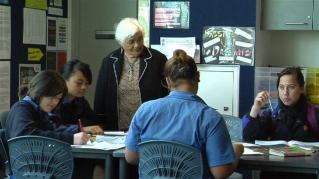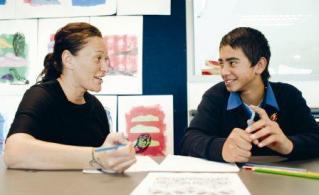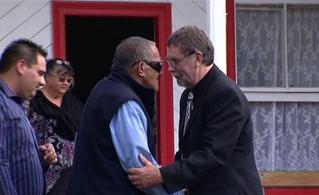Transcript
Narration
Whānau and community involvement in school life can, and should, extend beyond supporting the school at cultural and sporting activities, and lead to engagement which directly supports students’ learning.
Dexter Waru – Student, Tolaga Bay Area School
I reckon it’s very important for parents to get involved with schoolwork that we have been doing because then we can talk about it at home, and at school as well.
Benita Tahuri – Te Kahua Facilitator
I still think that it’s very hard. I still think many of our whānau don’t even want to come near schools, don’t want to come near mainstream schools.
Narration
The starting point is making whānau feel welcome.
Paula Walker – Parent, Hiruharama School
I guess they call it an open door policy. It’s just another extension of your own kitchen. That’s how we’re made to feel here.
Bill Hughes – Principal, Hiruharama School
There’s always kai on the table, and it’s not our kai. We have people sending us in smoked eels and smoked stingray, kahawai, Māori bread cakes. If children haven’t got lunch, or if they’ve forgotten lunch or whatever, they just come in and they just ask. It’s not a staffroom. And everyone shares in it. And because of that, whānau feel welcome coming in, and helping themselves to a cup of tea, and clean up all the teachers’ dishes.
Narration
At Hiruharama, whānau have been fully immersed in the strategic planning process.
Bill Hughes
Last year I had the strategic-thinking hui. But there were over thirty whānau represented – between 30 and 40 whānau represented. And they came up with basically where they want Hiruharama School to go over the next three years.
Merekatene Tuhura – Parent, Hiruharama School
We came in and split up into different groups, because there were too many parents to have all in one group. And then they asked us, sort of, different questions on, like, what would we like to see at school, what areas would we like our children to learn in; and in our groups you brainstorm on it.
Bill Hughes
And that wasn’t only just our parents, but there were nannies and papas who responded.
Matekino Tuhura – Parent, Hiruharama School
I’m not the only who’s invited. I’ve got a sister in Te Puia whose child goes to Te Puia School – my sister’s also invited. Do you see what I mean? It goes out to the extended whānau – aunties and uncles, cousins. Whomever thinks they have something to contribute to the school is more than welcome to attend the strategic planning.
Aroha Hamilton – Parent, Hiruharama School
We get to see the draft version, before it becomes written in stone. And if you have any objections, additions, you can voice those, and you actually get listened to.
Wally Penetito – Lecturer, Victoria University of Wellington
If communities are going to learn to relate to schools, and schools are going to have to learn to relate to communities, then a lot of listening has to be done with each other, in each others’ territory.
Benita Tahuri
We’ve got to stop thinking we know what whānau want and just ask. Because whānau will tell you, as a school, an institution, it’s what you do with that after they say it which is the important step.
Keriana Tawhiwhirangi – Director, Principals’ Development Association
And it’s how we ask, and it’s how often we ask. And it’s how many opportunities we provide for people to be safe in terms of responding openly, honestly and frankly about what we are doing.





